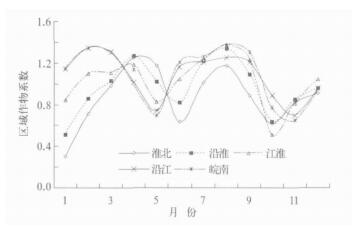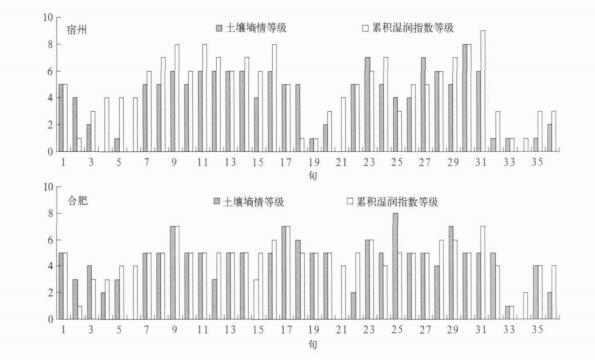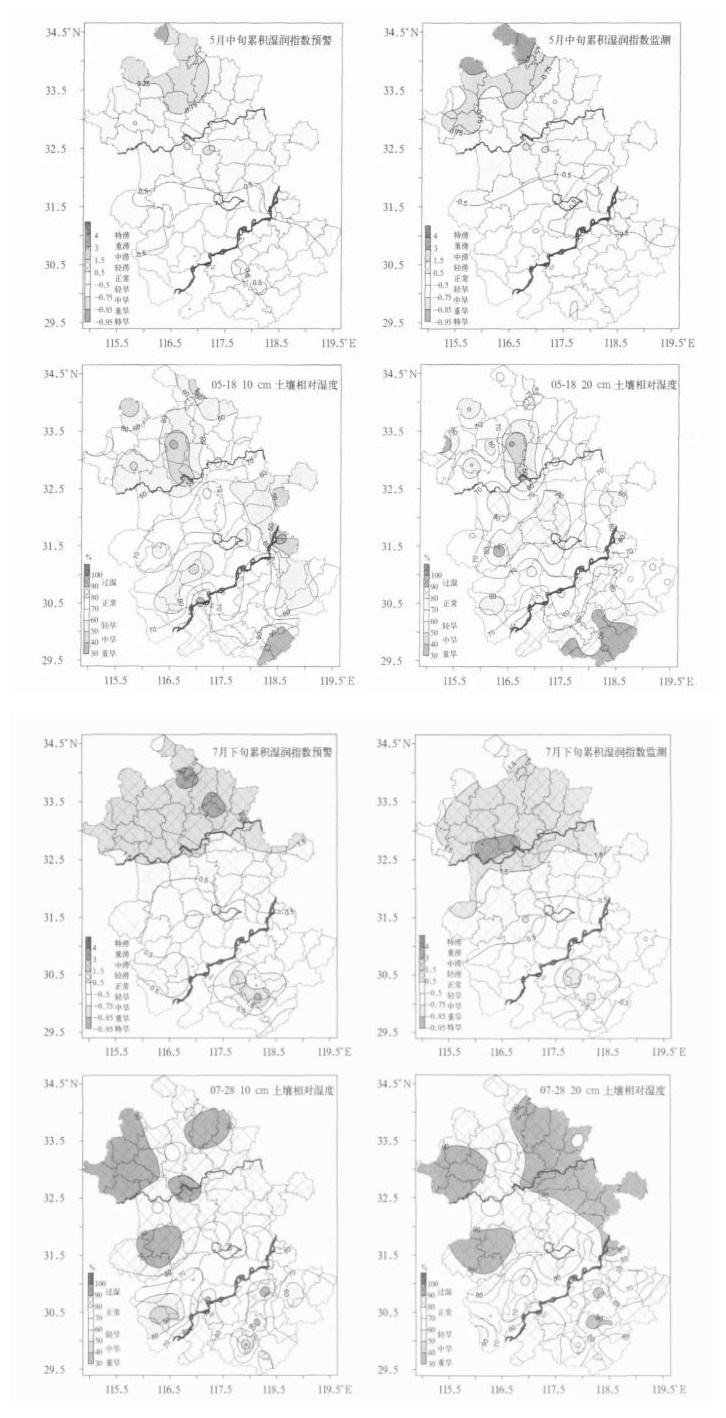农业旱涝指标及在江淮地区监测预警中的应用
The Agricultural Drought and Flood Index and Its Operational Application to Monitoring and Early-warning in Jianghuai Area
-
摘要: 该文提出了一个可业务应用的农业旱涝监测预警气象指标———累积湿润指数。该指标以相对湿润度指数为基础, 用作物需水量取代参考作物蒸散量, 并考虑前期旱涝程度对当前旱涝状况的累积影响, 具有农业意义。为方便农业气象业务应用, 采用FAO Penman-Monteith模型的简化方法计算参考作物蒸散量, 用气温资料对简化式进行校准, 将误差减小到可满足应用要求; 通过求算不同区域农田作物系数的加权平均值, 得到宏观农田作物需水量, 并确定了该指标分区域的旬旱涝等级标准。该指标用于旱涝监测, 与土壤墒情的定性符合率为80%~90%, 定量符合率为60%~70%, 在旬时间尺度比土壤墒情指标更符合旱涝实况; 用于下一旬旱涝预警, 尽管受到中期降水量预报准确度影响, 但由于含有前期旱涝实况信息, 预警趋势大体正确, 提高了旱涝预警的准确度。Abstract: An accumulated humidity index is introduced as agricultural drought and flood indicator and can be applied to operation. The index bases on the relative humidity index, replacing evapotranspiration with the crop water requirements, and the influence of former drought and flood status to current ones is considered too. Each component's time efficiency and effect weight varies on different temperature condition.The effect weight of every ten days are also different.The reference evapotranspiration is estimated and calibrated using temperature data of actual measurement, and errors are eliminated to meet application requirement, thus FAO Penman-Monteith is available for operation. The macroscopical crop water requirements is obtained by compositive crop coefficients in different region, also the grades of drought and flood index of a ten-day period in the humid and semi-humid zones are established.Used in agricultural drought and flood monitoring, and the qualitative coincident between this index and the soil moisture indices reaches 80%—90%, and quantitative coincident percentage is 60%—70%. The soil moisture data of longer serial stations are more consistent with accumulated humidity index than with regional survey result; normal and relative normal drought and flood grade leads to the highest coincident rate, drought the second, while flood leads to a relative low result. Since there is great difference between the soil moisture and cumulated humidity index in the monitoring aging and means, 10%—20% errors can be considered acceptable. Considering the index of the coincident ratio for stations, every grade samples proportion of total and its coincident ratio, the accumulated humidity index reflects soil moisture status in general.This index is used in agricultural drought and flood early-warning, the reliability of which is influenced by medium-term forecast.It contains former droughts and flood facts, making the trend relatively accurate on the whole. Considering the operation requirement, the early-warning precision still needs improvement. On one hand, the day-to-day data can be obtained by analyzing information of middle-term precipitation course prediction; on the other hand, statistical method is used to predict the index on basis of temporal characteristics analysis, to adjust the error of precipitation prediction, and improve the accuracy of agricultural drought and flood early-warning.The agricultural drought and flood are primary agrometeorological disasters in China, so the monitoring and the early-warning operation is a key agrometeorological job. At present, there are indexes on agricultural drought and flood such as soil moisture index, remote sensing index and meteorological index. But considering the complexity of agricultural drought and flood, the above indexes each has advantage and weakness, therefore strengthening research on compositive technique for the agricultural drought and flood is necessary.
-
表 1 1994-2003年安徽省35个台站旬参考作物蒸散量简化式和精确式误差分析
Table 1 Error analysis on simplified and precise formulas of the reference evapotranspiration for 35 stations in Anhui during 1994-2003

表 2 权重系数α随旬平均气温的变化
Table 2 The changes of weighting coefficient α with ten-day mean temperature

表 3 累积湿润指数Ma区域旬旱涝等级标准
Table 3 The classes of droughts and floods of accumulative humidity index in ten days

表 4 累积湿润指数和土壤墒情等级检验及应用结果
Table 4 Results of the comparision between the classes of accumulative humidity degree index and those of soil moisture

-
[1] 秦大河, 丁一汇, 王绍武, 等.中国西部生态环境变化与对策建议.地球科学进展, 2002, 17(3):314-319. http://www.cnki.com.cn/Article/CJFDTOTAL-DXJZ200203002.htm [2] 王石立.近年来我国农业气象灾害预报方法研究概述.应用气象学报, 2003, 14(5):574-582. http://qk.cams.cma.gov.cn/jams/ch/reader/view_abstract.aspx?file_no=20030572&flag=1 [3] 何方.应用生态学.北京:科学出版社, 2003:405-425. [4] 袁文平, 周广胜.干旱指标的理论分析与研究展望.地球科学进展, 2004, 19(6):982-991. http://www.cnki.com.cn/Article/CJFDTOTAL-DXJZ200406014.htm [5] 赵艳霞, 王馥棠, 裘国旺.冬小麦干旱识别和预测模型研究.应用气象学报, 2001, 12(2):235-241. http://qk.cams.cma.gov.cn/jams/ch/reader/view_abstract.aspx?file_no=20010231&flag=1 [6] 刘建栋, 王馥棠, 于强, 等.华北地区农业干旱预测模型及其应用研究.应用气象学报, 2003, 14(5):593-604. http://qk.cams.cma.gov.cn/jams/ch/reader/view_abstract.aspx?file_no=20030574&flag=1 [7] 丁太胜, 胡雯, 马晓群, 等.江淮流域旱涝灾害气象卫星遥感监测和预报方法研究.高原气象, 2003, 22(2): 147-154. http://www.cnki.com.cn/Article/CJFDTOTAL-GYQX200302008.htm [8] 朱自玺, 刘荣花, 方文松, 等.华北地区冬小麦干旱评估指标研究.自然灾害学报, 2003, 12(1):145-150. http://www.cnki.com.cn/Article/CJFDTOTAL-ZRZH200301023.htm [9] 陈雷, 杨兴国, 把多辉, 等.甘肃省农业干旱动态监测指标的确定及其应用.干旱地区农业研究, 2005, 23(1):144-156. http://www.cnki.com.cn/Article/CJFDTOTAL-GHDQ200501029.htm [10] 张润霞, 侯茂生, 陈宇卫, 等.安徽省主要自然灾害及综合减灾战略构思.自然灾害学报, 2003, 3(1):15-24. http://www.cnki.com.cn/Article/CJFDTOTAL-ZRZH199401002.htm [11] 朱煌武, 吴华章, 张来平, 等.近10年安徽省的各类灾害及发展趋势.灾害学, 2003, 18(1):64-70. http://www.cnki.com.cn/Article/CJFDTOTAL-ZHXU200301012.htm [12] 陈玉民, 郭国双, 王广兴, 等.中国主要作物需水量与灌溉.北京:水利电力出版社, 1995:77-95. [13] Allen R G, Pereira L S, Raes D, et al.Crop evapotranspiration:Guidelines for Computing Crop Water Requirements// FAO Irrigation and Drainage Paper 56. 1998. [14] 王加虎, 郝振纯, 姜彤.气温增加对长江流域参照蒸散发的影响研究.湖泊科学, 2003, 15(增刊):277-288. http://www.cnki.com.cn/Article/CJFDTOTAL-SZYY200601010.htm [15] 丁德峻, 张旭晖.江苏苏北地区主要作物需水量的初步研究.自然资源, 1994(3):90-94. http://www.cnki.com.cn/Article/CJFDTOTAL-ZRZY403.008.htm [16] 彭世彰, 索丽生.节水灌溉条件下作物系数和土壤水分修正系数试验研究.水利学报, 2004(1):17-22. http://www.cnki.com.cn/Article/CJFDTOTAL-SLXB200401004.htm [17] http://www.ahnw.gov.cn/2OO6nykj/iframe.asp?c=4&ntype=4. -


 设为首页
设为首页 加入收藏
加入收藏



 下载:
下载:


